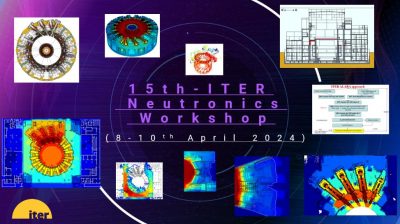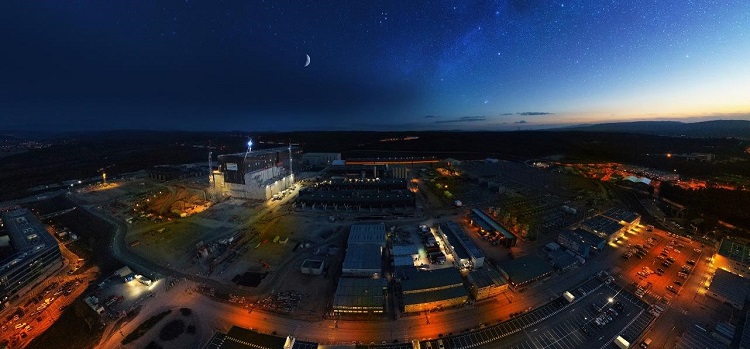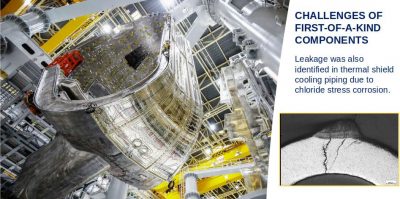
From April 8th through 10th (2024) the ITER Organization gathered researchers, industry partners and all members of the international neutronics community in Cadarache, where the fusion reactor homonymous to the organisation is undergoing construction, to host the 15th Neutronics Meeting and Fusion Neutronics Workshop. Aiming to discuss recent advancements, issues and successes in the neutronics field, the meeting covered several topics including ITER neutronics, safety issues, computational tools and nuclear data relevant to nuclear fusion, shielding materials, damage, heating, waste production and management and neutron sources, among others.
Ezequiel Goldberg, member of the Fusion Group, attended the meeting where researchers made presentations from both public and private institutions from Spain, France, Italy, Germany, Finland, Slovenia, the UK, the US, Russia, India, Korea, Japan, China, and international organisations such as the ITER Organization and the IAEA (International Atomic Energy Agency).
ITER is currently one of the most ambitious energy projects in the world. It is an endeavour in which 35 nations are collaborating to build the largest tokamak in the world, a type of magnetic fusion device, based on the same principle that powers the Sun and stars, designed to prove that fusion is a feasible large-scale and carbon-free energy source. However, it is worth noting that despite its scale, ITER is a research device to demonstrate that nuclear fusion can be an effective and efficient energy source, as well as to test technologies essential for a fusion reactor, such as superconducting magnets and tritium breeding modules that enable the tritium self-sufficiency needed to sustain the reaction. It is also the precursor to future demonstration devices which will be connected to the energy grid.

Throughout the workshop, one topic that permeated a wide variety of presentations was the use of artificial intelligence (AI). This applied both to supporting certain types of simulations, for example using neural networks for variance reduction methods to speed up Monte Carlo simulations, as well as using AI techniques as the method itself for calculating nuclear heating within the context of a fusion tokamak. As with every computational method, AI has some strengths as well as drawbacks over traditional simulation methods, as can be the finite element method (FEM) or Monte Carlo (MC).
One of the event’s most interesting and important talks was the opening presentation given by Pietro Barabaschi, director-general of ITER, about the progress and challenges in the construction of the reactor. After introducing his talk, he provided some information on the delivery of components, stating that there is a delay in the delivery of the remaining vacuum vessel sectors but that all the magnets are currently at the construction site. The equipment installation for the cryogenic plant is complete and has entered the pre-commissioning phase.
He continued to explain that some repair work has been going on in vacuum vessel sectors due to distortion of the joints for the sector-to-sector welding, given that the tools designed and created to weld the vessel sectors require a highly precise alignment. One of the reasons for choosing to perform the repairs over changing the approach of the welding was due to observing evidence of chloride stress corrosion in some cooling pipes of the thermal shield. The corrosion happened because, during fabrication, there was a process of washing with hydrochloric acid before applying nickel and silver coatings, and the acid remained in some crevices underneath the cooling pipes. Due to residual stress conditions, the corrosion went through the pipes and if not fixed, with time this could potentially lead to leaking through the thermal shield during operation. So, the painful decision was made to disassemble one sector module and work is being done to repair these pipes in parallel with the repairs for the vacuum vessel sectors welding.

Inevitably, this repair work along with other issues has caused some delays in the entire project. As a consequence, a review of the baseline is being prepared with a proposal to be presented to the ITER Council in mid-2024. This new baseline has changed the planning for the experimental phase. Originally, the first plasma was set to be at the end of 2025, with a modest current, followed by a lengthy shutdown to install the first wall and blankets, moving on to the following phase. As of the revision, it has been decided to move directly to the maximum magnetic energy in the first experimental phase without the final first wall, without DT (deuterium-tritium) reactions and commission the magnetic system for disruptions, relativistic electrons and any potential risk during the following phases up to the maximum current. This order of events can shorten the delay to reach the maximum magnetic energy.
In his presentation, Mr Barabaschi also expressed that ITER is collaborating and supporting the private sector efforts towards fusion energy. They are committed to sharing knowledge of the successes and what hasn’t worked. Given that ITER will produce neutrons at seven orders of magnitude higher than current fusion devices, the required level of analysis is highly complex and impactful, considering both the reliability of the device and discussions with regulators.
The Fusion Group appreciates the possibility of participating in this event hosted by the ITER Organization and hopes to participate again in future editions, especially the next ITER neutronics workshop to be held next year at UNED (Universidad Nacional de Educación a Distancia) in Madrid, Spain.
